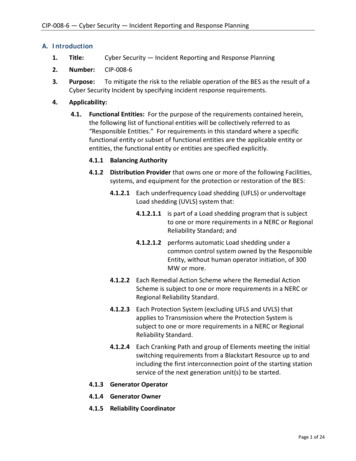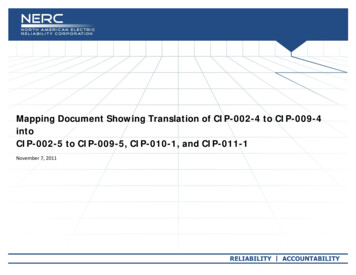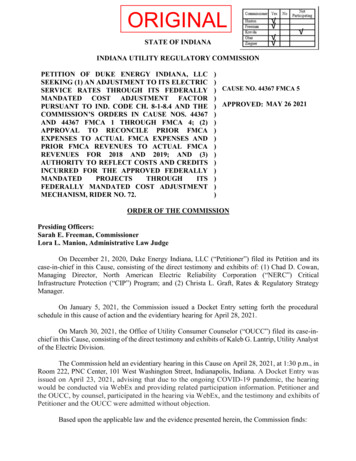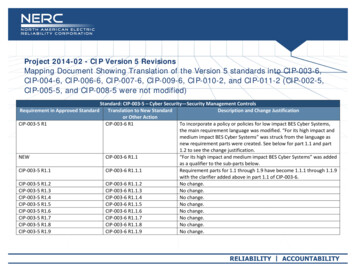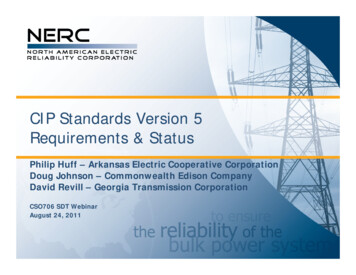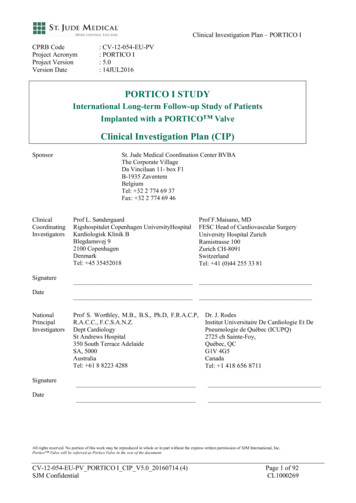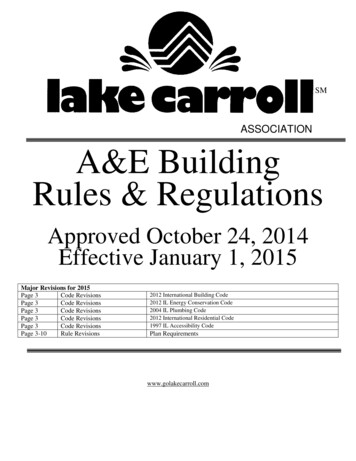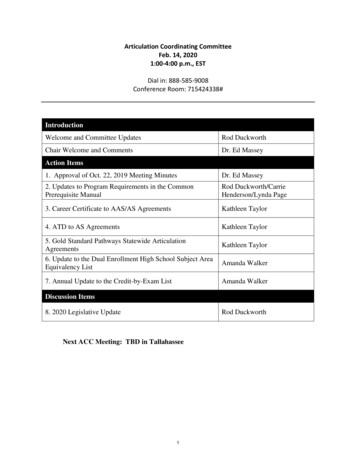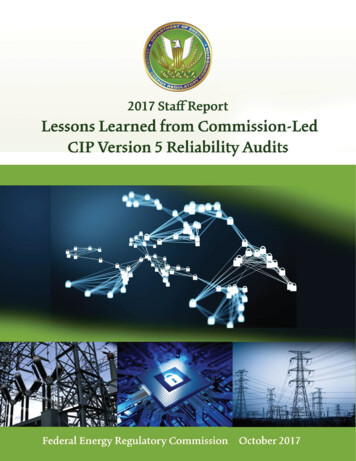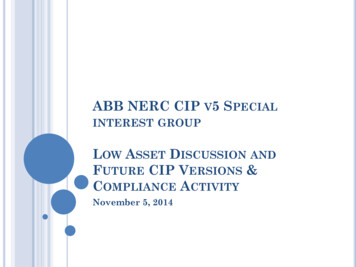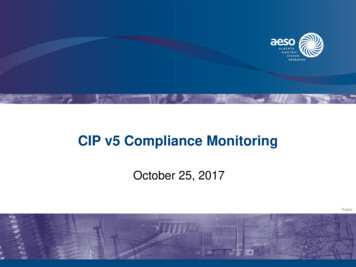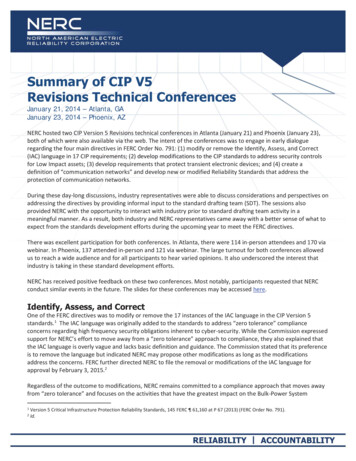
Transcription
Summary of CIP V5Revisions Technical ConferencesJanuary 21, 2014 – Atlanta, GAJanuary 23, 2014 – Phoenix, AZNERC hosted two CIP Version 5 Revisions technical conferences in Atlanta (January 21) and Phoenix (January 23),both of which were also available via the web. The intent of the conferences was to engage in early dialogueregarding the four main directives in FERC Order No. 791: (1) modify or remove the Identify, Assess, and Correct(IAC) language in 17 CIP requirements; (2) develop modifications to the CIP standards to address security controlsfor Low Impact assets; (3) develop requirements that protect transient electronic devices; and (4) create adefinition of “communication networks” and develop new or modified Reliability Standards that address theprotection of communication networks.During these day-long discussions, industry representatives were able to discuss considerations and perspectives onaddressing the directives by providing informal input to the standard drafting team (SDT). The sessions alsoprovided NERC with the opportunity to interact with industry prior to standard drafting team activity in ameaningful manner. As a result, both industry and NERC representatives came away with a better sense of what toexpect from the standards development efforts during the upcoming year to meet the FERC directives.There was excellent participation for both conferences. In Atlanta, there were 114 in-person attendees and 170 viawebinar. In Phoenix, 137 attended in-person and 121 via webinar. The large turnout for both conferences allowedus to reach a wide audience and for all participants to hear varied opinions. It also underscored the interest thatindustry is taking in these standard development efforts.NERC has received positive feedback on these two conferences. Most notably, participants requested that NERCconduct similar events in the future. The slides for these conferences may be accessed here.Identify, Assess, and CorrectOne of the FERC directives was to modify or remove the 17 instances of the IAC language in the CIP Version 5standards.1 The IAC language was originally added to the standards to address “zero tolerance” complianceconcerns regarding high frequency security obligations inherent to cyber-security. While the Commission expressedsupport for NERC’s effort to move away from a “zero tolerance” approach to compliance, they also explained thatthe IAC language is overly vague and lacks basic definition and guidance. The Commission stated that its preferenceis to remove the language but indicated NERC may propose other modifications as long as the modificationsaddress the concerns. FERC further directed NERC to file the removal or modifications of the IAC language forapproval by February 3, 2015.2Regardless of the outcome to modifications, NERC remains committed to a compliance approach that moves awayfrom “zero tolerance” and focuses on the activities that have the greatest impact on the Bulk-Power System12Version 5 Critical Infrastructure Protection Reliability Standards, 145 FERC ¶ 61,160 at P 67 (2013) (FERC Order No. 791).Id.
reliability. The CSO 706 SDT added the IAC language to address the “zero tolerance” issues while rewarding entitieswith robust programs that addressed deficiencies. In light of potential removal of this language, NERC staff and thetechnical conference participants engaged in an open dialogue on how to address compliance issues, including adiscussion of the Reliability Assurance Initiative (RAI), which had not fully matured at the time the IAC language wasadded to the standards in mid-2012.Conference attendees offered numerous considerations and comments, including the following:xHow can a modified version of the CIP Standards avoid moving back toward a zero tolerance model whileaddressing FERC’s concerns of the IAC language, especially since industry is not aware how RAI will beimplemented?xCan the timing and balloting process for the revised standards be successful only if RAI is in a more maturestate?xThe underlying issue is with the IAC language, not the concept. Will the implementation window for Version5 allow RAI and the enforcement pilots to mirror the timelines for the drafting efforts and the maturationof RAI processes?Following the IAC discussion, NERC staff presented information about the enforcement pilots and RAI’s link toVersion 5 and future standard development. Similarly, NERC staff gave an update on the CIP Version 5 TransitionStudy activity. The lessons learned from the Transition Study will be posted on the CIP Version 5 Training Programweb site3 and may be in scope for revisions by the SDT as appropriate.4 Below is a timeline of all of the activitiesrelating to CIP Version s/Transition-Program.aspxWhile the focus of the Standards Authorization Request (SAR) is to address the directives from FERC Order No. 791, it may be appropriate tomake modifications to the CIP Version 5 standards based on the lessons learned from the Transition Study.4Summary of CIP V5 Revisions Technical Conferences2
Low Impact Assets ProtectionsA key aspect of the CIP Version 5 Reliability Standards that differs from earlier versions is that they expandapplicability to BES Cyber Systems that previously were not directly subject to the standards. As a result, BES CyberSystems that are categorized as Low Impact assets must comply with CIP-003-5, Requirement R2. This requirementdirects responsible entities to develop policies that address four technical areas: cyber security awareness, physicalsecurity controls, electronic access controls for external routable protocol connections and Dial-up Connectivity, andincident response to a Cyber Security Incident.In FERC Order No. 791, the Commission stated that, “the CIP version 5 Standards, however, do not require specificcontrols for Low Impact assets nor do they contain clear, objective criteria from which to judge the sufficiency of thecontrols ultimately adopted by responsible entities for Low Impact BES Cyber Systems.”5 The Commission furtherstated that this “absence of objective criteria” would lead to ambiguity and result in inconsistency among entities’compliance with the requirement.6Therefore, the Commission directed NERC to develop modifications to the CIP Version 5 Reliability Standards toaddress these concerns. In FERC Order No. 791, the Commission suggested four alternatives for addressing thedirective. The Commission stated that in responding to this directive, NERC could either define a set of appropriatecontrol objectives for Low Impact assets, define the specific controls that would apply to Low Impact assets, providegreater specificity for the processes in CIP-003-5, Requirement R2, or pursue an equally efficient and effectivesolution.7Based on this context, the conference participants provided input for the SDT to consider when addressing the LowImpact assets directive. Among the considerations offered by conference attendees:xControls or criteria should be commensurate with the level of risk an asset poses.xEntities of all sizes should be included in the development process; some entities have never had to complywith CIP Reliability Standards prior to this Version.xRequirements should provide flexibility for entities to develop physical security controls appropriate for thelevel of difficulty inherent in securing open areas.xScalability of electronic access controls is important.xConsider device-type and/or facility-type security measures.xConsider the monitoring practices for some types of assets when assessing incident response planrequirements.xRefer to Electricity Sector Information Sharing and Analysis Center (ES-ISAC) history during development.5FERC Order No. 791 at P 107.Id. at P 108.7 Id.6Summary of CIP V5 Revisions Technical Conferences3
xIdentify requirements applicable to Low Impact assets in a requirement that is separate from thoserequirements that apply to Medium and High Impact assets.xUse previous versions of CIP Standards, particularly Version 3, as reference points because many entitieshave already built security infrastructures based on those requirements.xInclude a desired or expected outcome within the requirements.xConsider including the following specific controls in the requirement(s) for Low Impact BES Cyber Systems:oFence heightoLock typesoEntry control procedures.Communication NetworksThe CIP Version 5 Reliability Standards do not refer to communication networks within the definition of CyberAssets. The CSO 706 SDT determined that inclusion of communication networks in that definition would lead toconfusion in the implementation of Version 5 standards. The SDT stated that many components of communicationnetworks cannot strictly comply with the Version 5 standards.FERC noted in Order No. 791 that the Cyber Asset definition should not include communication networks.8However, the Commission was concerned that a gap in protection may exist becuase the CIP version 5 Standards donot address security controls needed to protect the nonprogrammable components of communication networks.9As a result, FERC directed NERC to develop a definition of communication networks and develop either new ormodified Reliability Standards addressing the protection of nonprogrammable components of communicationnetworks.10 FERC further directed NERC to file the modifications for approval by February 3, 2015.11 NERC alsonotes that communications security is a topic of the FERC Staff-led conference, and the outcome of that conferencemay further inform the approach used to resolve this directive.The technical conference participants offered considerations for the SDT in developing the scope of the definitionand whether a new or modified standard would best address the directive. The attendees provided the followinginput for the SDT’s consideration:xInclude a risk assessment of specific access points rather than only looking within a perimeter.xUse a threat-based approach in identifying risk.xDetermine whether entities have control over particular aspects of a network (i.e., vendors may controlcertain segments).8Id. at P 148.Id. at P 149.10 Id. at P 150.11 Id.9Summary of CIP V5 Revisions Technical Conferences4
xWhen defining communication networks, determine what could be considered part of BES Cyber Systemsso there is no overlap.xDraft language in requirements in a manner to survive changes in technology.xBalance adequate protections with exclusions of assets that should not be in the definition.xFirst determine what needs to be protected, then consider the definition and protections in requirements.xKeep NERC’s jurisdictional restrictions in mind.xDraw upon the expertise of communications professionals when drafting the definition.xConsider whether the directives pertaining to communication networks should be a standard outside theCIP suite of standards.xConsider the demarcation point as a critical component of the definition.xConsider physical versus logical protections.xBe aware of the potential impact of the definition and requirements on entities of all sizes.Transient DevicesThe CIP Version 5 Reliability Standards definition of BES Cyber Asset provides an exemption for a Cyber Asset if, for30 consecutive calendar days or less, it is directly connected to a network within an ESP, a Cyber Asset within anESP, or to a BES Cyber Asset, and it is used for data transfer, vulnerability assessment, maintenance, ortroubleshooting purposes.In FERC Order No. 791, the Commission stated that it “remain[s] concerned whether the CIP version 5 Standardsprovide adequately robust protection from the risk posed by transient devices.”12 The Commission further “expectsNERC to consider the following security elements when designing a Reliability Standard for transient devices orremovable media: (1) device authorization as it relates to users and locations; (2) software authorization; (3)security patch management; (4) malware prevention; (5) detection controls for unauthorized physical access to atransient device and; (6) processes and procedures for connecting transient devices to systems at different securityclassification levels (i.e. High, Medium, Low Impact).”13The technical conference participants offered considerations for the SDT in developing revisions to the Version 5standards that address the directive of protecting transient devices. The attendees provided the following input forthe SDT’s consideration:x1213Consider whether the directive is not to protect systems from transient devices, but to protect the transientdevices themselves. While encryption is available, perhaps specific controls should be specified andevidence should be provided.Id. at P 132.Id. at P 136.Summary of CIP V5 Revisions Technical Conferences5
xDefine “transient device,” and consider the following qualifications:oThere could be specific requirements identified as applicable to them and could possibly address thedirective.oTransient is something introduced to the environment and it needs to be protected from theenvironment.oWhatever is done, focus on what outcome might be and what controls might be needed.oEntities need to address what concerns might be, such as passwords, oversight, and protection ofmachines.oBased on device class type, define category and policy for temporary use.xEstablish controls appropriate for the device being connected and where the connection is occurring; thereis no “one-size-fits-all” approach.xIncorporate transient device protection mechanisms within configuration or change managementrequirements.xRecognize a device’s role and location, because some devices were never designed to be secure so antimalware tools also may not be effective.xDo not simply focus on thumb drives; controls for other devices should not be overlooked.xAvoid subcategorizing transient devices; technology constantly changes and new devices can hold/transferdata and possibly perform other actions.xDo not overlook existing requirements for protecting assets, whether in the context of remote access,internal processing, or other priorities.xAvoid restrictive requirements that will not be able to adequately address changing technology.xSpecify device protection requirements pertaining to updates that must be downloaded from vendor sites.xAddress protection mechanisms that may be implemented for BES systems from risks posed by plugging intransient devices; there are tools used to perform network analysis that could expose all vulnerabilities toanything that resides on the device.xDetermine whether the discussion of transient devices should be limited to the use of maintenancedevices; earlier discussions by the CSO 706 SDT may have been unwittingly restrictive.xConsider whether there should be controls in place to alert when something is connected to network andwhether certain systems or devices are segmented. Also consider if change control processes should bepart of this effort, such as a logging/monitoring client on Windows devices that automatically issues anotification when something is plugged in. Closing out unnecessary ports, change control and assetmanagement are logical fits for these processes.xConsider whether the DOE initiative on procurement might be appropriate to reference.Summary of CIP V5 Revisions Technical Conferences6
xAccount for different use cases; for example: technician laptops used at multiple sites; laptops represent agreater threat than static PCAs; also consider flash drives, vendor devices, and remote access issues.xAssess whether the one year deadline for addressing the cited issues is appropriate; there were differentopinions expressed by conference attendees as to its feasibility.xReview the current standard language to determine whether it introduces a vulnerability regardingtransient devices.xAuditability is an issue because of the lack of records.SurveyIn FERC Order No. 791, the Commission “directed NERC to conduct a survey of Cyber Assets that are included orexcluded under the new BES Cyber Asset definition during the CIP version 5 Standards implementation periods.”14The Commission further expects NERC to explain “(1) specific ways in which entities determine which Cyber Assetsmeet the 15 minute parameter; (2) types or functions of Cyber Assets that are excluded from being designated asBES Cyber Assets and the rationale as to why; (3) common problem areas with entities improperly designating BESCyber Assets; and (4) feedback from each region participating in the implementation study on lessons learned withthe application of the BES Cyber Asset definition.”15NERC reached out to the participants to gauge options for conducting this survey as well as ideas to effectivelygather the input FERC directed NERC to collect while not being overly burdensome. Participants provided theirviews on the different avenues NERC can take to produce the results needed for the informational filing, and NERCis working to incorporate some of the feedback in developing its survey.Next StepsThe Standards Committee appointed the SDT on January 29, 2014. The SDT consists of ten members, including twoco-chairs. The first SDT in-person meeting will be held February 19-21, 2014 at NERC’s offices in Washington, D.C. Ifyou would like to follow the SDT’s development activity, please visit the project page on NERC’s website hereand/or send a request to Marisa Hecht or Ryan Stewart to be added to the team’s “plus” email list.1415Id. at P 124.Id.Summary of CIP V5 Revisions Technical Conferences7
Summary of CIP V5 Revisions Technical Conferences January 21, 2014 - Atlanta, GA January 23, 2014 - Phoenix, AZ NERC hosted two CIP Version 5 Revisions technical conferences in Atlanta (January 21) and Phoenix (January 23), both of which were also available via the web. The intent of the conferences was to engage in early dialogue
